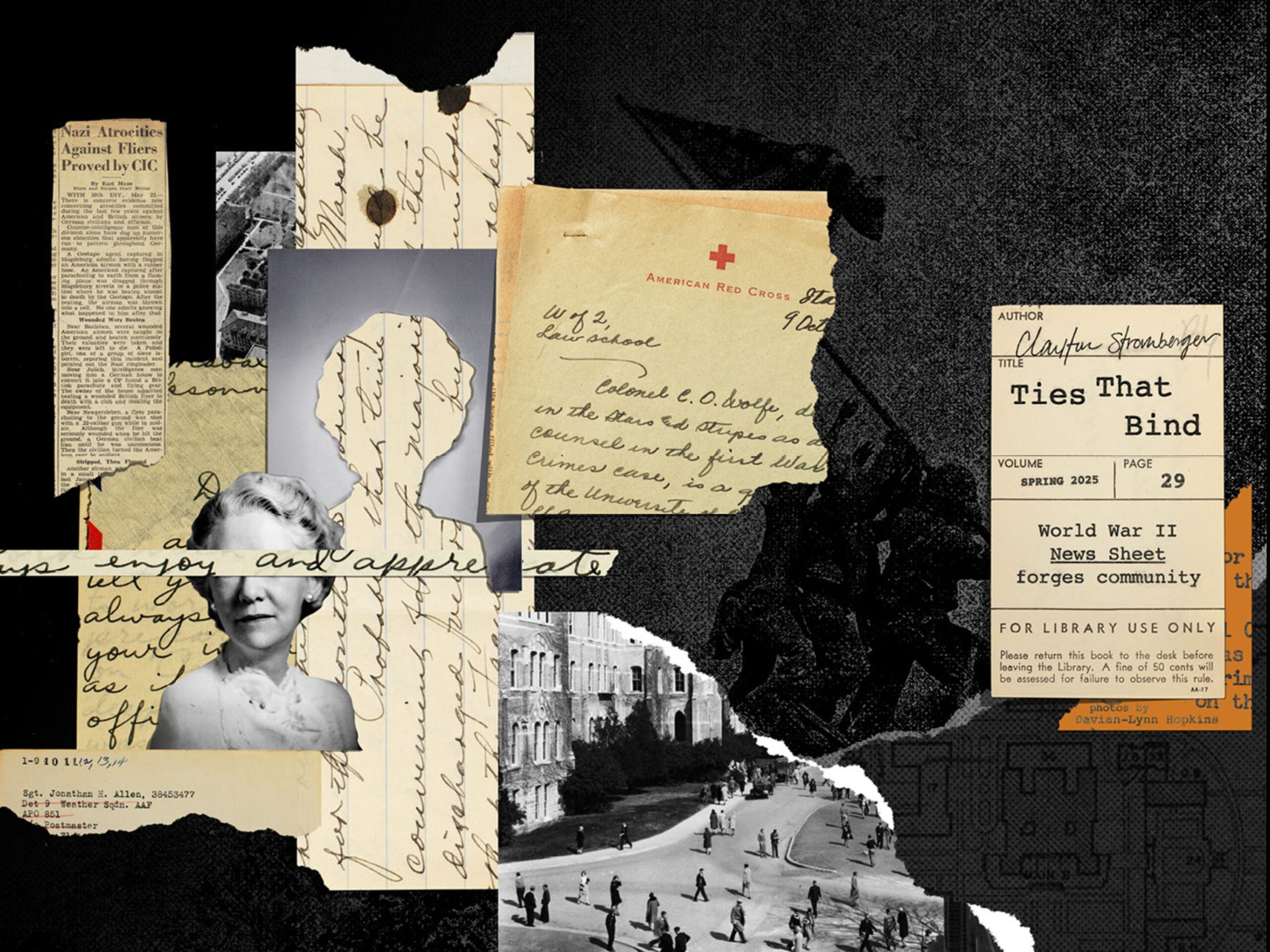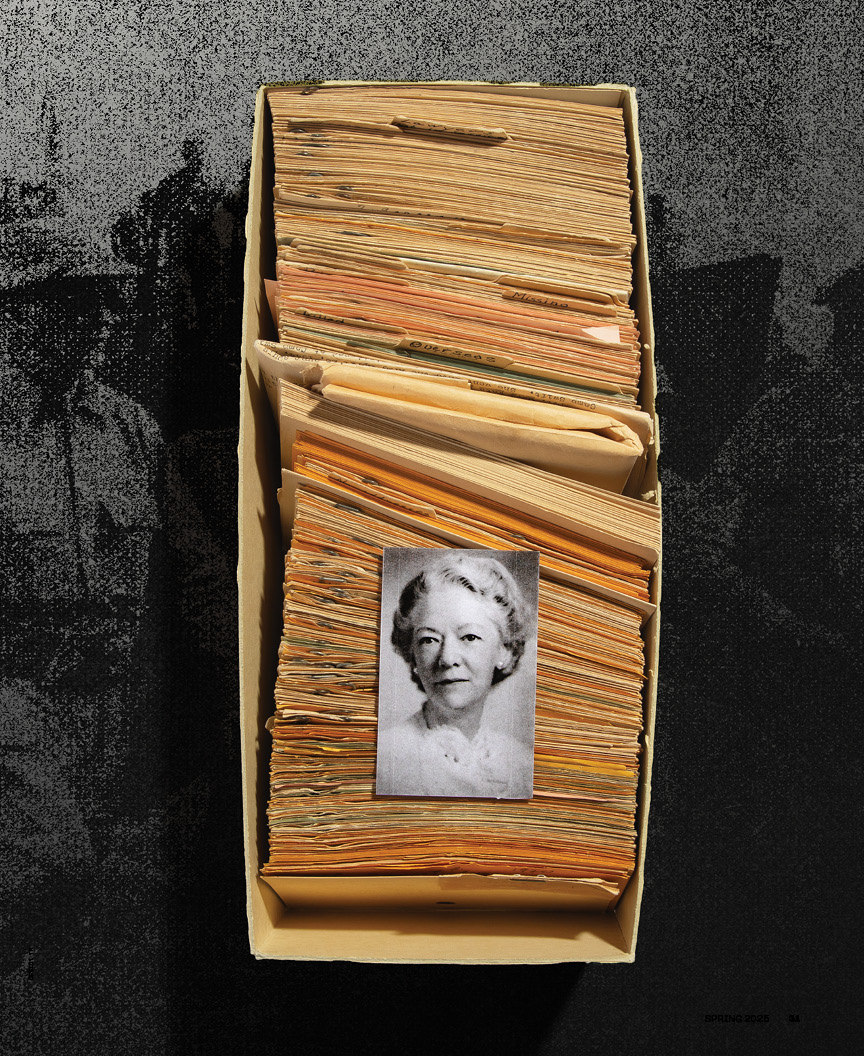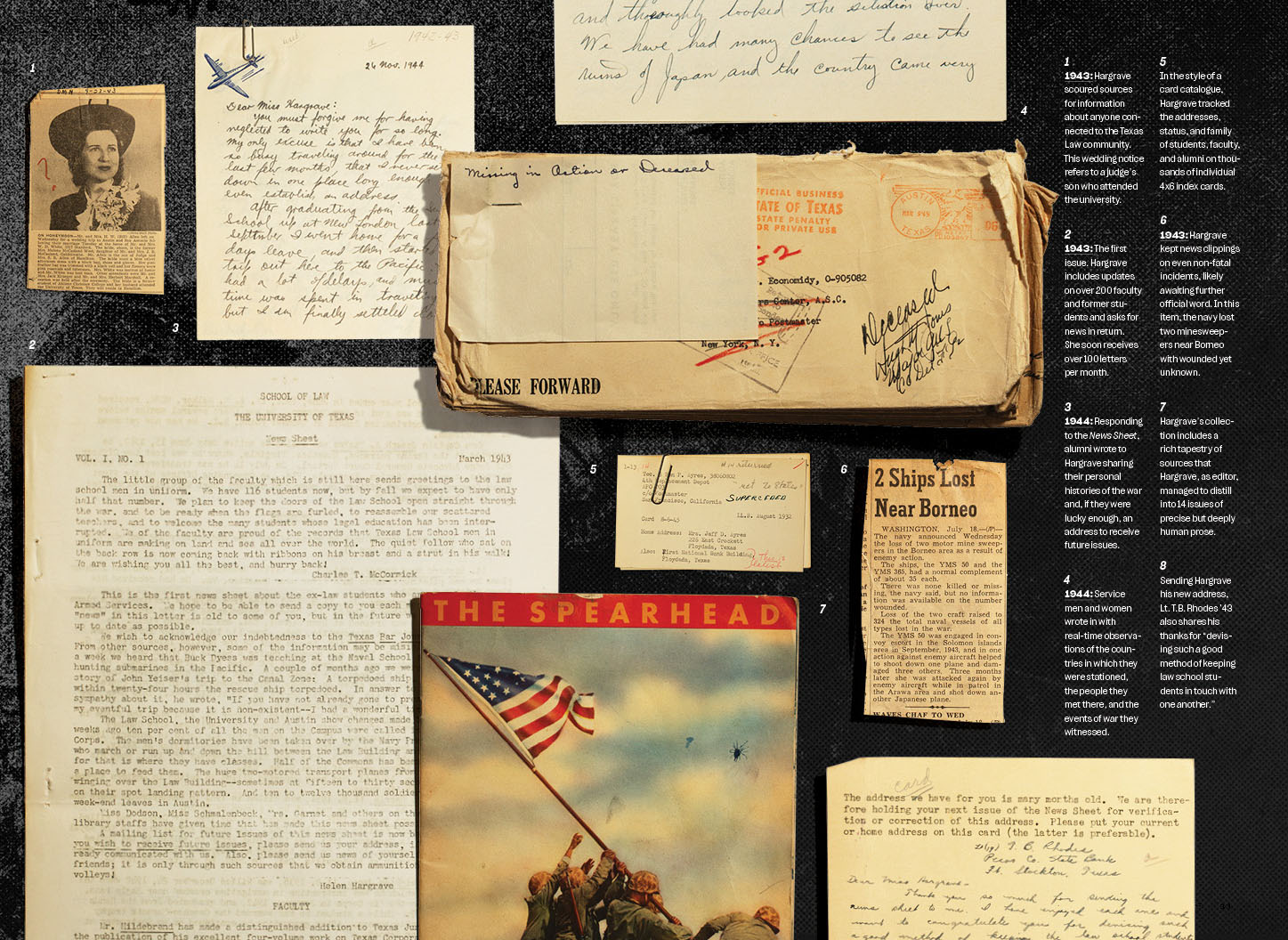
World War II News Sheet Forges Community
Written by Clayton Stromberger
Art by Davian-Lynn Hopkins
From her third-floor perch in the old Law Building at 21st and Speedway, head librarian Helen Hargrave, class of 1926, could look out the library’s large windows — often opened on all three sides to let a breeze pass through — and witness a university transformed by wartime. Transport planes rumbled overhead on their way back to Del Valle Army Air Base; Navy cadets filed by on their way to class. All too often the vista was one of a quiet, almost deserted Forty Acres, its sidewalks and lawns missing the usual swirl of cheerful collegiate life.
It was February 1943, just over one year since Pearl Harbor, and young men and women who might otherwise have been poring over cases were now scattered around the globe. With the nation called to arms, enrollment at the law school plummeted from 720 students in 1940-1941 to just 40 in the fall of 1943. The law school was mostly empty with a half-dozen professors carrying on classes for the few remaining students. At Hargrave’s desk, the usual wave of reference requests slowed to a trickle.
"I envy your place as I would certainly like to be at one of those places where so much is going on."—Helen Hargrave
“I envy your place,” Hargrave wrote that year to a student who had joined the service, “as I would certainly like to be at one of those places where so much is going on.”
Librarians track things down — so, determined to do her part in the war effort, Hargrave decided to use her research and organizational skills to determine the whereabouts of the many former students and faculty from Texas Law now serving across the country and around the world. Like a rear detachment commander setting up her field of operations, she turned the Law Library into the headquarters of the News Sheet, a monthly newsletter created to help the extended family of the law school community feel connected in a time of ongoing peril.
Through 14 issues over two and a half years, Hargrave’s News Sheet followed the ebb and flow of the war — Guadalcanal, North Africa, Italy, D-Day, Japan. It was a brief but transformative window of time, one in which the head librarian became, as she told an interviewer upon her retirement, “a newspaper publisher.” At the publication’s peak circulation, Hargrave and the remaining secretarial staff wrote, edited, copied, and mailed 2,500 copies of each issue of the News Sheet to men and women stationed around the world.
With the tumult of World War II, the tragedies inherent in war, the uncertainty for the future, and perhaps the largest mobilization of humanity ever, Hargrave’s News Sheet built and sustained a network of thousands of alumni, interrupted students, and faculty with a monthly dose of warm friendship, professional insights, shared pride, and, most importantly, encouragement.
The First Issue
Hargrave, with the backing of Dean Charles T. McCormick and initial funding from the UT System Board of Regents, launched the first News Sheet in March 1943. It was typed with the help of library staff — single-spaced, front and back, on six sheets of legal-sized paper — then mimeographed, folded, and stuffed into envelopes to be dispatched around the world.
Dean McCormick opens the first News Sheet with a greeting.
“The little group of the faculty which is still here sends its greetings to the law school men in uniform. We have 116 students now, but by fall we expect to have only half that number. We plan to keep the doors of the law school open straight through the war, and to be ready when the flags are furled, to reassemble our scattered teachers, and to welcome the many students whose legal education has been interrupted.”
Each New Sheet edition was a long “letter from home” crammed chock full with news from the State Bar, musings on the latest edition of Texas Law Review, and tales of campus life and Texas football, as well as updates on members of Texas Law community. Hargrave drew from a wide array of sources, including letters from soldiers themselves, notes from relatives of alumni, and clippings from The Daily Texan, Alcalde, Stars and Stripes, and various national and Texas newspapers.
"I wish you could have seen the Campus a little before eight. There were faint lines of light in the East, the stars were bright as Texas stars always are, and every branch and leaf on the trees and every blade of grass not covered with snow was white with hoar frost. The notes of the bugle were very clear that morning as the future naval fliers raised the flags before the Main Building."—Helen Hargrave, News Sheet editor
Right: An image of Helen Hargrave sits on a single drawer from her card catalogue of various alumni, divided here as “Missing,” “Killed,” and “Overseas.”

Much of any one News Sheet concerns promotions, reassignments, awards — but also abounds with shouts of long-lost friends greeting one another in improbable locales, tales of Aggies bumping into Longhorns on the other side of the world, and anecdotes about “The Eyes of Texas” being sung and taught to others. There are hairbreadth escapes and dramatic rescues. A reader can almost hear the constant thrum of B-17s or destroyers on the move, the splash of a landing craft crashing through waves, and the harrowing whine of incoming mortar fire.
Soldiers mailing in their news might depict vividly the sounds and sights of Italy, England, or an island in the Pacific where they were stationed, most often comparing poorly to Texas. There are surprising gems, like a note about a rare chance to hear J. Frank Dobie — then teaching at Cambridge University — speak at a dinner for service members from Texas at the American Embassy in London (“He has not lost any of his Texas accent,” reported Lt. Marion L. Key, ’41).
"It seems to me that any person who survives a series of bombing attacks must inevitably become imbued with some definite conviction — either indifferent fatalism or a complete faith in divine protection."—Walter Ely Jr. ’35, rear gunner, Guadalcanal [and future 9th Circuit Court of Appeals justice]
And they share unfiltered truths about war, too. “When discharged in July 1919 as a Major of Infantry, I thought the war to end wars had been won. I had no idea that in 1942 I would again don the uniform of an army officer. But, Hitler has rudely interrupted all of the peaceful plans of this peace-loving nation, and here I am along with millions of others again, teaching methods of killing human beings in the quickest and most efficient way.” That’s Lt. Col. W. R. Brown ’21, describing the experience of many WWI veterans serving their country again in WWII.
And, of course, readers of the News Sheet learn of classmates taken prisoner and killed in action. “It is these losses that grieve us all,” Hargrave mourns in a reply letter to Carlisle Blalock ’45. Throughout the News Sheets, Hargrave functions as a gentle guide to this staggering amount of information. Her editorial voice is by turns somber and dignified, uplifting, lyrical, openly proud of the Law School, its traditions and former students, and at times, dryly witty.
Who’s Who
By the summer of 1943, a hundred letters or V-mails per month from the war theater or military training bases poured into Hargrave’s office — chatty letters and terse updates, sometimes signed off with, “Somewhere in Germany,” or “Somewhere in the Pacific,” as required by the government censors.
"I make a very poor conqueror. No matter how hard I try to hate and to get pleasure out of the suffering and destruction about me, it is useless. Hungry Germans do not look different from any other hungry people in the world ... [F]or me as a so-called combat soldier, the war has always been an asbtract reality too big to fully comprehend, I have not learned to hate sufficiently."—Don Gayer ’40
The 14 issues of the News Sheet include references to alumni dating as early as the Class of 1885 — in October 1943, a Victory Ship named for alumnus Thomas W. Gregory, a WWI veteran and former U.S. Attorney General, launched from Galveston, TX — with more numerous updates on students who graduated or attended nearer the start of the war.
Covering five decades of graduates, plenty of familiar historical names pop off the pages, like Allan Shivers ’33, John Connally ’41, and Lloyd Bentsen ’42. But with thousands of entries over the 14 issues, the News Sheet offers glimpses of less well-known graduates who bring their own intrigue. Like Ann Van Wynen ’43, who, upon graduating law school, had a brief intelligence-related mission in Portugal before taking her State Department post as American Vice Consul in Johannesburg, South Africa. And Staff Sergeant Don Gayer ’40, with Army Public Relations always near the frontlines, whose letters convey brutal inhumanity and poignant tenderness through first-hand accounts of liberating concentration camps near Hannover, Germany.
It’s Personal
The News Sheet would have been profoundly personal for Hargrave, a Michigan native who enrolled at UT in both education and law in 1923. She graduated Texas Law top of her law class in 1926 and in 1930 became Texas Law’s assistant law librarian, taking over as head librarian in 1940. That meant she had either studied with, met, or assisted almost every student who had passed through the doors of the law school for almost two decades. She knew them. They were like family.
Through her efforts, Hargrave captured slivers of a momentous time in world history, in all its sprawl, variety, inhumanity, and humanity. It was perhaps not their original intent to create a historical record — but they certainly did, which may explain why the Library of Congress requested copies of the News Sheets after the war.
Victory
As the end of the war drew near, the News Sheet turns homeward with updates about “refresher courses” the Law School would offer returning soldiers, the GI Bill, and the progress on plans for building a new home for the law school, which would open eight years later in 1953 as Townes Hall.
The last News Sheet dated August 1945 had a somber but triumphant tone and included Hargrave’s description of the scene on campus after victory was declared — the Tower was lit orange, a cannon fired from the Capitol, and “a siren shrieked, the only time since 1942 for a practice air raid.”
After the war, Hargrave continued as head librarian and, in 1950, became the first tenured female law professor at Texas Law, a position she held until her retirement in 1971.
Looking back on the success of the News Sheet mission she said simply: “It was a great satisfaction.”
To the wider community, her efforts were a lifeline.
“Had it not been for you, thousands of us would never have known what law members had done, where they were, and how many gave their lives. You could not have done a more valuable service if you had been in uniform. The stuff you have sent out has brought all kinds of memories to men all over the world. One reads what Bill or Tom or John so-and-so had done, or that he has died, and remember sitting next to him in class, or what he said over coffee at Hilsberg’s, or how badly he felt when he saw his grades, or how elated when he saw a high grade, or some funny incident that happened when he was reciting. One knows that Helen Hargrave with her sympathetic personality, her soft, beautifully toned voice, and her soft femininity is there. One pictures the law library, the battered tables, the class pictures, the old building — one even can smell the library. You have brought them a fragment of their life, for many in the war, the poetry of their existence.”— James L.M. Miller ’35
Eighty years ago this spring, the United States celebrated VE-Day. When the war finally ended a few months later, no one knew whether war-interrupted students would return to law school or whether there would be jobs for returning lawyers.
But Texas Law had an advantage. For the droves of returning students and lawyers, the Law School had a community forged through battle and shaped by the meticulous care of Professor Helen Hargrave, one item, one envelope, one address, and one News Sheet at a time.

2 – 1943: The first issue. Hargrave includes updates on over 200 faculty and former students and asks for news in return. She soon receives over 100 letters per month.
3 – 1944: Responding to the News Sheet, alumni wrote to Hargrave sharing their personal histories of the war and, if they were lucky enough, an address to receive future issues.
4 – 1944: Service men and women wrote in with real-time observations of the countries in which they were stationed, the people they met there, and the events of war they witnessed.
5 – In the style of a card catalogue, Hargrave tracked the addresses, status, and family of students, faculty, and alumni on thousands of individual 4×6 index cards.
6 –1943: Hargrave kept news clippings on even non-fatal incidents, likely awaiting further official word. In this item, the navy lost two minesweepers near Borneo with wounded yet unknown.
7 – Hargrave’s collection includes a rich tapestry of sources that Hargrave, as editor, managed to distill into 14 issues of precise but deeply human prose.
8 – Sending Hargrave his new address, Lt. T.B. Rhodes ’43 also shares his thanks for “devising such a good method of keeping law school students in touch with one another.”
